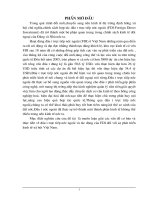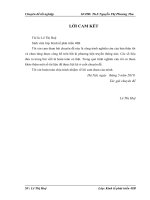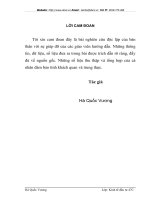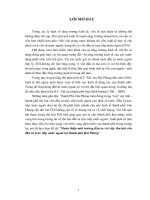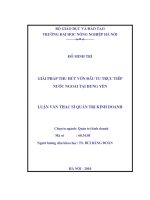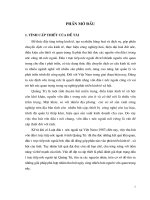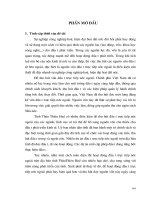Mô hình dự báo thu hút vốn đầu tư trực tiếp nước ngoài tại Tỉnh Thái Nguyên
Bạn đang xem bản rút gọn của tài liệu. Xem và tải ngay bản đầy đủ của tài liệu tại đây (696.68 KB, 89 trang )
PREDICTION MODEL IN ATTRACTING FOREIGN DIRECT
INVESTMENT IN THAI NGUYEN PROVINCE
A Doctor Thesis Presented to
The Faculty of Graduate School
Southern Luzon State University, Lucban, Quezon, Philippines
in Collaboration with
Thai Nguyen University, Socialist Republic of Vietnam
In Partial Fulfillment of the
Requirement for the Degree
Doctor of Business Administration
Trinh Viet Hung
(Hung)
April 2014
2
CERTIFICATE OF ORIGINALITY
This is to certify that the research work / thesis entitled “Analysis of
Factors Affecting Foreign Direct Investment and the Construction Of Prediction
Model for a Sustainable FDI Attraction to Thai Nguyen Province”, orally
defended/ presented under the DBA Program jointly offered by Southern Luzon State
University of the Republic of the Philippines and Thai Nguyen University of the
Socialist Republic of Vietnam, embodies the result of original and scholarly work
carried out by the undersigned.
This thesis does not contain words or ideas taken from published sources
or written works by other persons which have been accepted as basis for the award of
any degree from other higher education institutions, except where proper referencing
and acknowledgement were made.
_____________________
Researcher/Candidate
Date Orally Defended: __________________
Noted:
ASSOC. PROF. NGUYEN TUAN ANH
Dean
International School
Thai Nguyen University
Date: __________________
3
ABSTRACT
The objectives of the study is to analyse the factors affecting FDI attraction to
Thai Nguyen Province. The study was conducted in August 2013 in Thai Nguyen.
The data utilized in the research included primary data obtained through a
questionnaire survey with 32 FDI investors in Thai Nguyen Province in August 2013
and secondary data from statistical yearbook and reports of the provincial and central
government. The results obtained from exploratory factor analysis and multivariate
regression analysis showed that factors affecting FDI attraction to Thai Nguyen
Province included: Policy, Confidence of Investors, Infrastructure. In which, Policy
has the highest fluence on FDI attraction. The study also constructed a prediction
model for FDI attraction to Thai Nguyen Province.
4
ACKNOWLEDGEMENTS
5
Table of content
CERTIFICATE OF ORIGINALITY 2
ABSTRACT 3
ACKNOWLEDGEMENTS 4
LIST OF TABLES 8
LIST OF FIGURES 9
CHAPTER 1 10
INTRODUCTION 10
Background of the study 10
Statements of the problem 15
Research objectives 16
1.1. Hypothesis 16
1.2. Scope and Delimitation of the Study 17
1.3. Significance of the study 18
CHAPTER 2 21
REVIEW OF RELATED LITERATURE AND STUDIES 21
2.1. Review of Related Literatures 21
2.2. Review of related studies 24
2.3. Conceptual Framework 30
CHAPTER 3 32
RESEARCH METHODOLOGY 32
3.1. Locale of the study 32
3.2. Research Design 32
Figure 6. Research Design 32
3.3. Unit of analysis 33
3.4. Data 33
Sources of Data 33
Population, Sample size and Sampling Techniques 33
Instrument of data collection 33
3.5. Description of Respondents 34
3.6. Statistical Treatment 35
CHAPTER 4 37
DATA PRESENTATION, ANALYSIS AND INTERPRETATION 37
4.1. Analysis of primary data on investors’ expert opinion on factors affecting FDI
attraction to Thai Nguyen Province 37
4.2. Analysis of secondary data on factors affecting FDI in Thai Nguyen Province 51
6
CHAPTER 5 59
Summary of Findings, Conclusions and Recommendations 59
5.1. Summary of Findings 59
5.2. Conclusion 69
5.3. Recommendations 71
1. Thai Nguyen Province should focus on offering financial incentives for FDI
investors. For real estate businesses, Thai Nguyen Province should focus on interest
rate preferentials; for companies in manufacturing and processing industries, tax and
land incentives for factory construction may take better effects. 71
2. Thai Nguyen Province should develop its electric and water supply to ensure the
production and manufacturing of FDI investors and have contingency plans for
emergency cases. 71
3. Thai Nguyen Province should improve the confidence of investors by applying
transparent and equal policies for all investors. Information about investment and
investment policies should be published in the portal of Thai Nguyen Province. The
province should also increase its PCI to improve the confidence of foreign investors. 71
4. Thai Nguyen Province should support foreign investors in training human
resource by cooperating with foreign companies in recruitment process and training
(such as language and skills in working in an international environment). Workers
who are introduced to foreign companies should be the ones who are skillful and has
strong sense of discipline. 71
5. Thai Nguyen Province should develop its supporting industries to supply
materials and reduce the costs for major industries. 72
6. The transport system should be improved. 72
7. Thai Nguyen Province should maintain its stable economic growth, which is
attractive to the investors. 72
8. Based on the changes of variables in the model (3), Thai Nguyen Province can
make decisions on how to attract FDI appropriately. 72
9. The following further research can be conducted to develop the result of this
study: 72
Direction 1: quantify the policy factors into an equivalent amount of money that the
investors may receive from the application of specific policies so that the model can
approach the reality. 72
Direction 2: further research can be conducted to explore specific needs of the
investors, focusing on the factors which have been found in this study as well as the
the fulfilment ability of Thai Nguyen Province in those factors. Solutions should be
proposed for both sides. 72
Direction 3: the study has proposed solutions to attract FDI, but has not suggested
any solution to retain the investors and expand their business in Thai Nguyen.
Therefore further study can be conducted with this objective. 72
REFERENCES 73
7
Hair, J.F. et. al. 2009. Multivariate Data Analysis (7th Edition). Prentice Hall 74
Stevens, J.P. 2002. Applied Multivariate Statistics for the Social Sciences, Fifth Edition.
Taylor and Francis group. 74
APPENDIX 76
Appendix A 77
QUESTIONNAIRE SURVEY FORM FOR INVESTORS/ 77
BẢNG CÂU HỎI ĐIỀU TRA 77
Appendix B 81
RESULT OF REGRESSION ANALYSIS ON SAS 81
2 GDP 2 0.1739 0.6926 14.5651 5.66 0.0387 86
CURRICULUM VITAE 87
Major Field: Economics 87
Degree obtained: Masters’ Degree 87
Year of Graduation: 2010 87
WORK EXPERIENCES 88
8
LIST OF TABLES
Table Page
Table 1. Correlation Analysis between FDI and socio-economic
index (2000-2012)
Table 2. Five point Likert’s Scale
Table 3. Description of Respondents’ Profile
Table 4. Factors before conducting EFA
Table 5. Correlation among variables (survey questions)
Table 6. Rotated component matrix
Table 7. Component Score Coefficient Matrix
Table 8. Reliability of the Exploratory Factors
Table 9. Average Mean Distribution of Investors’ Responses to
Factors affecting FDI attractiveness of Thai Nguyen
Province
Table 11. Simple correlation between FDI attractiveness and its
predictor factors
Table 12. Result of simple linear regression analysis on FDI
attractiveness as perceived by investors and its predictor
variables
Table 13. Summary of Backward Elimination
Table 14. Descriptive statistics of FDI and its predictor variables
from 2000 to 2013
Table 15. Simple Correlation Analysis between FDI and its
predictor variables
Table 16. Result of simple linear regression analysis on FDI in Thai
Nguyen Province and its predictor variables
Table 17. Summary of Forward Selection
9
LIST OF FIGURES
Figure
Page
Figure 1.
Gross Domestic Products of Thai Nguyen Province (2000-
2013)
Figure 2.
GDP by sectors in Thai Nguyen Province (2000
-
2013)
Figure 3.
Registered FDI in Thai Nguyen Province (2000
-
2013)
Figure 4.
Comparison of registered FDI among provinces (2010-
2013)
Figure 5.
Conceptual Framework
Figure 6.
Research
Design
Figure 7.
Model testing (primary model)
Figure 8.
Model testing (secondary model)
10
CHAPTER 1
INTRODUCTION
In recent years, a big change in trend of FDI inflows with a remarkable growth
in FDI to developing countries has been witnessed. Especially in 2012, developing
countries have surpassed their developed counterparts in attracting FDI with 9
developing countries ranked in top 20 FDI attractive countries (UNCTAD, 2013).
As reported by the United Nations Conference on Trade and Development
(UNCTAD, 2012), developing countries in Asia are the leadings to attract FDI during
the period from 2008 to 2012. Despite the decrease of 7% in FDI inflows in the whole
region in 2012, some countries including Vietnam were bright spots for labor-
intensive FDI. Vietnam was also considered one of most FDI attractive among low-
income host countries (together with Combodia, Myanmar and Philippines).
UNCTAD (2012) forecasted that Vietnam would be one of the potential attractive
hosts for the period 2013-2015.
Background of the study
Thai Nguyen Province is the central province of the Northern mountainous and
midland region of Vietnam in terms of politics and economy. It is also considered the
socio-economic gateway connecting the mountainous and the Red River Delta. Thai
Nguyen Province has border with Bac Can province in the North, Vinh Phuc, Tuyen
Quang in the West, Lang Son and Bac Giang in the East and Hanoi capital in the
South.
Thai Nguyen also has a very convenient location for transportation which is 50
kilometers far from Noi Bai International airport, 200 kilometers far from China and
200 kilometers from Hai Phong port. Thai Nguyen is also a transporting intersection
11
through the system of roads, railways, waterways. Thai Nguyen is located on the
highway 3 from Hanoi to Bac Can, Cao Bang and the border gate with China.
Thai Nguyen has a population of more than 1.2 million with variety of ethnic
groups such as King, Tay, Nung, San Diu, H’mong, San Chay, Hoa and Dao. In
addition, Thai Nguyen is also known as the third largest human resource development
center after Hanoi and Ho Chi Minh City with Thai Nguyen University, more than 11
colleges, 9 vocational colleges which offers training for more than 100.000 people
every year.
Thai Nguyen has abundant and diverse natural resources which can be
considered as a comparative advantage for the development of mining, and
metallurgical industry. Coal reserves in Thai Nguyen ranked second in the country
with fat coal reserves of more than 15 million tons, charcoal reserves of around 90
million tons, ferrous metals include tin, lead, zinc, tungsten, gold, copper, nickel,
mercury, etc. Minerals for construction materials are also potentials for cement and
paving stones manufacturing.
Infrastructures of the province such as electricity, water supply,
telecommunications and transportation have also been developed and convenient.
In recent years, there have been positive changes in the socio-economy of the
province with the growth in production in important industries, growth has been
witnessed in all sectors, especially non-public sector has shown its roles in the multi-
sector economy.
12
1999 2000 2001 2002 2003 2004 2005 2006 2007 2008 2009 2010 2011 2012 2013
0
5000
10000
15000
20000
25000
30000
35000
Figure 1. Gross Domestic Products of Thai Nguyen Province (2000-2013)
Figure 1 illustrates annual GDP growth of Thai Nguyen Province, from which
it can be seen that GDP increased gradually with years at the equal or higher in
compared with the whole country. In 2012, GDP of the province reached 29.508
billion VND, increased by 16% in compared with 2011.
1999 2000 2001 2002 2003 2004 2005 2006 2007 2008 2009 2010 2011 2012 2013
0
20
40
60
80
100
Figure 2. GDP by sectors in Thai Nguyen Province (2000-2013)
GDP (
Billion VND
)
Year
GDP
by sector
(
%
)
Year
Agriculture and Forestry
Industry and Construction
Service
13
Figure 2 shows GDP by sectors in Thai Nguyen Province, which has
transformed positively from 2000 to 2013. Growth in Industry and Construction
sector increased faster while that in Agriculture and Forestry sector grew slower than
the other sectors. The economy transformed sustainably.
1999 2000 2001 2002 2003 2004 2005 2006 2007 2008 2009 2010 2011 2012 2013 2014
0
500
1000
1500
2000
2500
Figure 3. Registered FDI in Thai Nguyen Province (2000-2013)
Figure 3 describes foreign direct investment registered to Thai Nguyen
Province in the duration of 2000-2013. In general, registered FDI in Thai Nguyen
Province had not many changes during 2000-2012 except for 2004 and 2007 when
registered FDI reached 148.1 million USD and 117.8 million USD.
However, in the first six months of 2013, registered FDI soared to 2.14 billion
USD which is an extraordinary increase in FDI inflows to the province.
Registered FDI
(
Million
USD
)
Year
14
2009 2010 2011 2012 2013
0
500
1000
1500
2000
2500
Figure 4. Comparison of registered FDI among provinces (2010-2013)
Figure 4 compares registered FDI between Thai Nguyen Province and other
provinces in the Northern region from 2010 to 2013. During 2010-2012, registered
FDI in Thai Nguyen Province was much lower than other provinces while that of Bac
Ninh, Quang Ninh and Phu Tho was quite high. However, in 2013, registered FDI to
Thai Nguyen Province increased dramatically to times of FDI to other provinces.
FDI had a positive effect to the economic growth, export and unemployment of
Thai Nguyen and contributed to the development of the province.
Table 1. Correlation Analysis between FDI and socio-economic index
(2000-2012)
FDI GDP EXP UNE
FDI
1
GDP
0.554
1
EXP
0.719**
0.931***
1
UNE
-
0.574*
-0.387
-0.327
1
* Significant a probability of 0.05
** Significant a probability of 0.001
*** Significant a probability of 0.0001
Where:
GDP : Gross Domestic Products (Billion VND)
FDI : Annual disbursed FDI (Million USD)
EXP : Export value (Thousand USD)
UNE : Unemployment rate (%)
Registered FDI
(
Million
USD
)
Year
Thái Nguyên
Bắc Giang
Phú Thọ
Quảng Ninh
Bắc Ninh
Vĩnh Phúc
15
FDI had a significant positive correlation with GDP growth and export value of
the province and had a negative impact to reduce unemployment rate. However, in the
past thirteen years, FDI inflows to Thai Nguyen Province was instable and
unpredictable. Particularly in 2013, FDI inflows to Thai Nguyen Province increased
significantly.
This situation raised to the researcher a question on which factors affecting FDI
inflows to Thai Nguyen Province and what can be proposed as recommendation for
the province to maintain stable FDI inflows in order to help promote the socio-
economic development of the province.
After reviewing literature and studies relating to status of FDI in Vietnam,
especially in Thai Nguyen Province, the researcher came to a decision to conduct this
research with the aims of analyzing factors influencing FDI inflows and finding out
the core problems in FDI attraction to the province, from which to come up with
recommendations for Thai Nguyen to employ and apply the most effective methods
into FDI attraction.
For all the reasons above, the researcher would like to conduct the study entitled:
“Analysis of Factors Affecting Foreign Direct Investment and the Construction
Of Prediction Model for a Sustainable FDI Attraction to Thai Nguyen Province”
and propose it to Thai Nguyen Province with the expectation of supporting the
development of the province in particular and the whole region in general.
Statements of the problem
The research aims at determining and analyzing factors affecting foreign direct
investment to Thai Nguyen Province necessary in maintaining stable FDI inflows.
The factors that were taken into account came from the Economic and market factors,
Political and policy factors, Natural resources and geographical conditions, Social
16
conditions. Thereafter, the researcher will propose appropriate solutions and
suggestion to enhance the FDI inflows to Thai Nguyen Province.
Research objectives
This study aimed to formulate the prediction model in attracting FDI in Thai
Nguyen Province. Particularly, the purpose of this study is to answer the following
questions:
1. What is the profile of the company in terms of:
- Name;
- Country of investor;
- Years of investment in Thai Nguyen Province;
- Nature of business;
- Investment capital.
2. What are factors affecting FDI attractiveness of Thai Nguyen province based
from investors’ expert opinion in terms of:
- Economic and market factors;
- Natural conditions and infrastructure;
- Political and policy factors;
- Social condition factors;
What model can best predict FDI inflows to Thai Nguyen Province?
3. What strategies should be proposed for the enhancement of FDI inflows in
Thai Nguyen Province?
1.1.Hypothesis
The study focused to test these two hypotheses:
(1) Factors affecting FDI attractiveness to Thai Nguyen Province:
=
0
+
1
×+
2
×+
3
×+
4
×
17
Where:
OAS : Overall assessment of FDI attractiveness as perceived by investors
POL : Policy factors
ING : Natural resource, and geographical factors
ECO : Economic and market factors
SOL : Social conditions
The hypothesis to be tested is:
:
=
=
=
=0
:
≠0
(
=1÷4
)
(2) Prediction model of FDI registered to Thai Nguyen Province:
=
+
×
+
×
+
×
+
×.
+
×.
+
×.
+
×
+
×
+
×
+
Where:
FDI : FDI registered in Thai Nguyen Province in year t (Million USD)
GDP : Gross domestic products in year t-1 (Billion VND)
EXP : Export value of Thai Nguyen Province in year t-1 (Thousand USD)
PCI : Provincial competitiveness index in year t-1
P.FIN : Financial incentives for investors in year t (if yes: 1, if no: 0)
P.LAND : Land incentives for investors in year t (if yes: 1, if no: 0)
P.ADMIN : Administrative privileges for investors in year t (if yes: 1, if no: 0)
INFR : National budget expenditure for development in year t-1 (Billion VND)
INFL : Inflation rate in year t-1 (%)
URB : Urbanization year t-1 (%)
The hypothesis to be tested is:
:
=
=
=
=
=
=
=
=
=0
:
≠0
(
=1÷9
)
1.2.Scope and Delimitation of the Study
The study aims to determine and analyze the factors affecting FDI attraction to
Thai Nguyen Province. The researcher proposed to collect primary data through
information provided by questionnaire survey for respondents who were holding a
management position at 32 FDI enterprises in Thai Nguyen Province in August, 2013.
The secondary data was also obtained from reports on socio-economy, yearly
statistical books and reports of the Vietnam Chamber of Commerce and Industry from
2000 to 2013.
18
1.3.Significance of the study
The results of this research will be of benefit to the policy makers of Thai
Nguyen Province in shape an appropriate promotion policy to maintain the FDI
inflows to Thai Nguyen as what it performed in 2013. Also, limitation and drawbacks
in provincial strategy of FDI attraction will also be found, from which will help them
to design better strategy for FDI attraction for the province. Moreover, the results
shall be used as a significant reference for the provincial government to make the
most realistic development plan which is suitable with the characteristics of the
province, attach FDI attraction to the long-term development of Thai Nguyen
Province, and to draw focused policies in the development plan of the province.
If the results of this research is applied, it would help to enhance the FDI
attraction performance of Thai Nguyen Province in the most sustainable way. This, in
turn, will help to improve the growth and development of Thai Nguyen, create more
jobs and reduce poverty and unemployment.
The research will also enable FDI investors to raise the voice of their seeking
for an effective and competitive investing environment. This will create more
available opportunities for investors if they invest to Thai Nguyen.
The results shall also be applied to other provinces in the Northern mountainous
region of Vietnam which have similar conditions to Thai Nguyen, this will forms a
basis for nearby provinces to conduct further research to give their own solutions for
their provinces.
For the researcher, the study is considered as an opportunity for her to have a
better understanding about the investments of Thai Nguyen Province. This will also
bring her more broader and deeper research ideas on FDI.
19
1.4.Definition of terms
Foreign Direct Investment Investment from one country into another
(normally by companies rather than
governments) that involves establishing
operations or acquiring tangible assets,
including stakes in other businesses
Registered FDI Total amount of FDI as registered in the
business registration to Thai Nguyen
Province
Disbursed FDI The amount of FDI disbursed at the time
of survey
Provincial Competitiveness Index Introduced in 2005 as the results of
fruitful collaboration between the
Vietnam Chamber of Commerce (VCCI)
and the U.S Agency for International
Development (USAID), the Provincial
Competitiveness Index (PCI), in order to
promote the development of the private
sector, is designed to assess the ease of
doing business, economic governance,
and administrative reform efforts by local
governments of 63 provinces and cities in
Vietnam.
Financial Incentives Incentives given to the investors such as:
tax incentives, interest rate incentives.
20
Land Incentives Incentives given to the investors such as:
land leasing, facilities
Administrative Incentives Incentives given to the investors such as:
assistance during administrative
procedures, investment and trade
promotion, etc.
21
CHAPTER 2
REVIEW OF RELATED LITERATURE AND STUDIES
This chapter presents the general discussion of the literatures and studies on
the foreign direct investment and its effect factors in the global and Vietnamese
context.
2.1. Review of Related Literatures
In any country, despite its level of development, resources for investment to
create new values and assets for the society are necessary for economic growth and
social development. Resources can be mobilized from both internal and external
forces from foreign countries. With regard to a developing country as Vietnam, with
the limitation in internal resources, and accumulation ability is low while demands for
investment are very high, resources from foreign direct investment then plays a very
important role.
According to the International Monetary Fund (IMF), FDI is defined as "an
investment for the long-term relationship”. According to this definition, an
organization in an economy (direct investor) obtained long-term benefits from a
business located in an economy.
United Nations Conference on Trade and Development UNCTAD also provides
a definition of FDI. Accordingly, FDI inflows include capital provided (either directly
or through a related company) by a foreign direct investment for FDI enterprises, or
home equity that foreign direct investment received from FDI enterprises. FDI has
three components: equity capital, reinvested earnings and loans within the company.
According to the 1987 Vietnamese Investment Law, foreign direct investment
is that foreign investors bring capital into Vietnam in cash and other assets to conduct
22
legitimate investment activity on a contractual basis or establishment of joint venture
company or 100% foreign investment company.
From the above definitions, foreign direct investment can be defined as
follows: “Foreign Direct Investment to a country is that foreign investors bring capital
in the forms of cash or assets in order to take the ownership or management of a
business in that country with the aim of benefit optimization”. Therefore, FDI is
always a type of business with a foreign firm. Two major features of FDI are the
existence of international capital movement and the investors use and manage their
capital directly.
The impacts of FDI to the economy of the recipient country depend on
elements of the macroeconomy such as: savings-investment ratio, international
economic and financial integration level. FDI influences the macroeconomy by (1)
increasing investment capital in recipient countries, (2) a more stable capital than
loans and (3) improving integration, external influences and reformation of the
economy, which cannot be achieved by internal capital.
FDI affects economic growth by increasing products or improving the
effectiveness natural resources use in recipient countries. This can be done through
channels: import-export, spillover effects and external effects to domestic enterprises.
Previous studies on effects of FDI to the economic growth have concluded:
Most of empirical research indicated that FDI in general has positive impact
on products and income of the recipient country, in plus to what domestic investment
can make. However, it is quite difficult to evaluate the degree of influence (OECD,
2002).
FDI, however, seemed to have less positive effects on economic growth in less
developed countries. Obviously, developing countries need to reach a specific level of
23
educational, technological and scientific development before being benefited from
foreign direct investment. Another element that also prevents a country in optimizing
the benefits of FDI is an inaccurate and less developed financial market (Hermes and
Lensink, 2000).
However, most of studies revealed positive effects of FDI to the economy (De
Mello (1999), Xu (2000), Reisen và Soto (2000))
Trade and investment were concluded to be interactive channels in foreign
investments. However, recipient countries need to consider short and mid-term effects
of FDI on foreign trade, particularly when facing financial pressure. Studies related to
this issue showed that in a developed country with a specific industrialization level,
FDI will help increase the international trade for the economic integration. Two
channels of tranferring the impacts of FDI to trade includes: the development of
business network and the importance of branches in distribution, sales and marketing
of multinational companies. It could be seen that FDI attraction ability of a
developing country is under a great influence of the ability of investor to approach
import and export activities. Therefore, countries who want to receive investments
should consider opening trade to be a strategy in attracting FDI in order to optimize
the benefits from this source of capital.
Technology transfer was considered as one of the most important external
impacts of FDI to a recipient country. However, the level of techonology development
of the recipient country is also important in this case. Previous studies showed that
whether FDI had positive or negative influence on products growth also depends on
the differences in technological development levels between domestic businesses and
foreign investors. When the technological development levels of domestic companies
24
is much lower than foreign investors, it will be more difficult for the former to receive
technological transfer from the latter.
The impacts of FDI on human resource development oftens take effects
through the government policies rather than individual FDI enterprises. Once a person
is employed, their knowledge and skills will be improved during their work and
training. Foreign investors also play an important and positive role in training the
human resource for the domestic partners that they are cooperating, including their
suppliers. When the human resource is improved, it can also result in a resonant
impact in circulating labor among firms, as well as enable staff to become the
business owners.
FDI and the presence of multinational companies has a great influence on
creating a competitive market in recipient countries. Foreign investors play the role of
improving the competitiveness and finally the growth in products, the decrease in
price and the effectivess of using human resources.
2.2. Review of related studies
A number of research has been conducted to define determinants of FDI. In this
section, the researcher focused on the publications in the context of developing
countries, especially in Asia as well as publication on FDI in Vietnam. Different
factors were concluded to be significant elements of FDI inflows, which can be
divided into groups as follows:
1. Economic and market factors
Among factors that were found to be important in encouraging FDI, products
seems to be discovered as contribute to FDI inflows by most researchers. Marcelo and
Mário (2004)’s research on a sample of 33 developing countries who played the role
of FDI hosts during the period from 1975 to 2000 using panel data methodology
25
found that the average rate of gross national products (GNP) growth over the previous
5 years had significant influence on FDI inflows. Holland and others (2000) also
mentioned in their paper on FDI in Eastern and Central Europe that a country growth
potential will attract more FDI. The same conclusion was also produced by Morisset
(2000) and Moosa (2002).
Another trend of studies on the relationship between FDI and GDP growth was
the reverse causality between these two variables. Borensztein and others (1995)
studying on data for the 1970 – 1989 period concluded that the effect of FDI on
economic growth depends on the level of human capital in the host countries. The
higher of human capital level, the more positive effect. Also, FDI encourage
economic grow through the increase of supplemental activities.
Economic index and its stability also tend to result in an attractive sign for
foreign direct investors. Justice (2012) researched on a number of previous papers on
FDI in Ghana said that many research showed that the exchange rate had a great
influence, especially volatility of exchange rate made a negative impact on FDI
inflow to the whole economy. Bende - Nabende (2002) collected data over the 1970 –
2000 also revealed the important role of real effective exchange rates to FDI of 19
Sub-Saharan African countries .
According to Ohlin (1933), low rates of interest in the host country would
produce high profits and possibility of financing, which motivated foreign investors.
Garibaldi and others (2001) suggested a number of economic variables such as market
size, fiscal deficit, inflation and exchange regime, risk analysis, economic reforms,
trade openness, availability of natural resources, barriers to investment and
bureaucracy which were significant in attracting FDI to transition economies.
